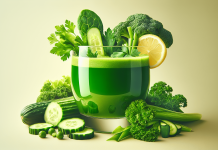If you’re looking for a delicious way to improve your digestive health, look no further than high-fiber juice recipes. Packed with nutrients and fiber, these refreshing drinks can help regulate your digestion and keep your gut happy and healthy. Whether you’re aiming to relieve constipation or simply want to enhance your overall well-being, these high-fiber juice recipes are sure to leave you feeling satisfied and revitalized. So, grab your juicer and get ready to give your digestive system the boost it deserves.
Review contents
Understanding the Importance of High-Fiber Juices for Digestive Health
How Fiber Promotes Digestive Health
Fiber plays a crucial role in maintaining a healthy digestive system. It is a type of carbohydrate that is not easily broken down by the body, meaning it passes through the digestive tract relatively intact. This contributes to the bulk of stool and promotes regular bowel movements, preventing constipation. Additionally, fiber acts as a prebiotic, providing nourishment for the beneficial bacteria in the gut that support optimal digestion and immune function.
Benefits of Consuming High-Fiber Juices
Incorporating high-fiber juices into your diet can have numerous benefits for digestive health. Firstly, it can help regulate bowel movements and prevent constipation. The added moisture from the juice can also soften the stool, making it easier to pass. Furthermore, high-fiber juices can promote satiety, reducing cravings and aiding in weight management. They can also help stabilize blood sugar levels, preventing spikes and crashes that can negatively impact digestion. Lastly, the increased fiber intake from juices can support a healthy gut microbiome, which is crucial for overall digestive health and immune system function.
Factors Affecting Digestive Health
Several factors can affect digestive health, and it’s important to address them in addition to incorporating high-fiber juices into your routine. Adequate water intake is paramount for proper digestion, as it helps soften the stool and prevent dehydration. Regular physical activity also plays a role in maintaining a healthy digestive system, as it promotes intestinal muscle contractions that aid in the movement of waste through the digestive tract. In addition, managing stress levels and getting enough sleep are crucial, as stress and lack of sleep can negatively impact digestion. It’s important to consider these factors alongside consuming high-fiber juices for optimal digestive health.
Choosing the Right Ingredients for High-Fiber Juices
Fiber-Rich Fruits for Juicing
When it comes to creating high-fiber juices, incorporating fiber-rich fruits is key. Fruits like apples, pears, and berries are excellent options, as they contain both soluble and insoluble fiber. Soluble fiber forms a gel-like substance in the digestive tract, providing bulk to the stool and promoting regular bowel movements. Insoluble fiber, on the other hand, adds bulk to the stool and helps prevent constipation. Other fiber-rich fruits such as oranges, kiwis, and bananas can also be included in your high-fiber juices to add variety and flavor.
Vegetables Packed with Fiber for Juicing
In addition to fruits, incorporating vegetables packed with fiber into your juices is essential for maximizing their digestive health benefits. Vegetables such as spinach, kale, and broccoli are excellent sources of fiber. These leafy greens are not only high in fiber but also contain important vitamins, minerals, and antioxidants that contribute to overall digestive health. Other fibrous vegetables like carrots, celery, and cucumber can also be great additions to your high-fiber juices, providing a pleasant balance of taste and nutrition.
Seeds and Nuts to Enhance Fiber Content
To further enhance the fiber content of your juices, consider adding seeds and nuts. Chia seeds, flaxseeds, and hemp seeds are excellent choices, as they are high in fiber and contain healthy fats that promote satiety. These tiny seeds can be easily incorporated into your juices, adding a subtle crunch and increasing their nutritional value. Additionally, almonds and walnuts can be blended into your high-fiber juices, providing a creamy texture and additional fiber and healthy fats.
Delicious High-Fiber Juice Recipes for Digestive Health
1. Green Goddess Juice
-
Ingredients:
- 2 cups spinach
- 1 cucumber
- 1 pear
- 1 green apple
- 1 tablespoon chia seeds
-
Instructions:
- Wash and prepare the ingredients.
- Add all the ingredients to a juicer and process until smooth.
- Stir in the chia seeds.
- Serve immediately and enjoy this refreshing green goddess juice that is packed with fiber and nutrients.
2. Berry Blast Juice
-
Ingredients:
- 1 cup strawberries
- 1 cup blueberries
- 1 cup raspberries
- 1 orange
- 1 tablespoon flaxseeds
-
Instructions:
- Wash and prepare the ingredients.
- Add all the berries and the peeled orange to a juicer and blend until well combined.
- Stir in the flaxseeds.
- Serve chilled and savor the vibrant flavors and fiber-rich goodness of this berry blast juice.
3. Tropical Sunshine Juice
-
Ingredients:
- 1 cup pineapple chunks
- 1 mango
- 1 banana
- 1 tablespoon hemp seeds
-
Instructions:
- Wash, peel, and chop the ingredients.
- Add the pineapple, mango, and banana to a juicer and process until smooth.
- Stir in the hemp seeds.
- Pour into a glass, garnish with a slice of pineapple if desired, and enjoy this tropical delight filled with fiber and tropical flavors.
4. Citrus Cleanse Juice
-
Ingredients:
- 2 oranges
- 2 lemons
- 2 tablespoons chia seeds
-
Instructions:
- Wash and squeeze the juice from the oranges and lemons.
- Combine the freshly squeezed citrus juices in a glass.
- Stir in the chia seeds and let the mixture sit for a few minutes to allow the seeds to absorb some liquid.
- Give it a final stir and relish this tangy and refreshing citrus cleanse juice, packed with fiber and cleansing properties.
5. Veggie Vitality Juice
-
Ingredients:
- 2 carrots
- 2 celery stalks
- 1 beet
- 1 handful spinach
- 1 tablespoon flaxseeds
-
Instructions:
- Wash and prepare the ingredients.
- Add all the ingredients to a juicer and process until well blended.
- Stir in the flaxseeds.
- Pour into a glass, add ice if desired, and indulge in this vibrant veggie vitality juice, rich in fiber and essential nutrients.
Tips and Tricks for Preparing High-Fiber Juices
Preparation Techniques to Retain Fiber Content
To ensure you’re getting the most fiber from your juices, it’s important to preserve its content during the preparation process. Start by properly washing and cleaning the fruits, vegetables, and seeds to remove any dirt or residue. Remember to leave the skin on when appropriate, as it contains a significant amount of fiber. If peeling is necessary, try to remove the thinnest layer possible to retain as much fiber as you can. Additionally, avoid straining the juice or using a fine mesh sieve, as this can remove some of the fiber. Instead, opt for juicers that retain the pulp or use a blender to create a fiber-rich smoothie.
Combining Ingredients for Optimal Fiber Intake
Experimenting with different combinations of ingredients can help you optimize your fiber intake. Mixing fruits and vegetables together can provide a well-rounded nutritional profile and prevent monotony. For example, pairing fibrous vegetables like spinach and kale with sweet fruits such as pineapple and apples can create a balanced and flavorful high-fiber juice. Including a variety of fiber-rich fruits, vegetables, and seeds in each juice recipe ensures that you’re benefiting from a range of nutrients and flavors.
Enhancing Flavor without Sacrificing Fiber
While the fiber content of your juices is important, so is the taste. Enhancing the flavor of your high-fiber juices without sacrificing fiber can be achieved in several ways. Consider adding fresh herbs like mint or basil to add a burst of freshness. Citrus fruits like lemon or lime can provide a tangy twist. You can also experiment with spices like ginger or cinnamon to add warmth and depth to your juices. Remember to start with small quantities and adjust according to your preference to strike the perfect balance between flavor and fiber.
Incorporating High-Fiber Juices into Your Daily Routine
Best Times to Consume High-Fiber Juices
To reap the maximum benefits of high-fiber juices, it’s important to consume them at strategic times. Starting your day with a high-fiber juice can kickstart your digestion and provide a nutrient boost. Consuming a fiber-rich juice mid-morning or mid-afternoon can help satisfy hunger and provide sustained energy. Alternatively, enjoying a high-fiber juice as a snack or part of your dinner can contribute to a well-rounded meal and promote overall digestive health. Find the timing that works best for you and make it a part of your daily routine.
Choosing High-Fiber Juices as Meal Replacements
High-fiber juices can serve as a convenient meal replacement option, especially when you’re on the go or in a time crunch. When opting for a high-fiber juice as a meal replacement, it’s crucial to ensure that it contains a balanced combination of fruits, vegetables, and protein-rich ingredients like seeds or nuts. Including protein in your meal replacement juice can help keep you fuller for longer and provide sustained energy throughout the day. Additionally, avoid relying solely on juices for nutrition and ensure you’re still consuming a variety of whole foods to meet all your nutrient requirements.
Integrating Juices with Fiber-Rich Snacks
Another way to incorporate high-fiber juices into your daily routine is by pairing them with fiber-rich snacks. Consuming a fiber-rich snack, such as whole-grain crackers with hummus or a handful of almonds, alongside your juice can help increase your fiber intake even further. This combination provides a balance of macronutrients and keeps you satisfied between meals. Additionally, choosing snacks that are high in fiber helps maintain a healthy digestive system and supports overall gut health.
Considerations and Precautions for High-Fiber Juice Consumption
Monitoring Fiber Intake for Digestive Sensitivity
While high-fiber juices can be beneficial for digestive health, it’s important to monitor your fiber intake if you have a sensitive digestive system. Some individuals may experience bloating, gas, or discomfort when consuming large amounts of fiber. Start by introducing fiber gradually and pay attention to any adverse reactions. If you experience discomfort, consider reducing the fiber content of your juices or consult a healthcare professional for guidance. It’s essential to listen to your body and make adjustments according to your specific needs and tolerances.
Potential Side Effects of High Fiber Consumption
Consuming high amounts of fiber, especially if you’re not used to it, can sometimes lead to side effects. These can include bloating, gas, diarrhea, or even nutrient malabsorption in extreme cases. It’s important to increase your fiber intake gradually and ensure you’re drinking plenty of water to help the fiber move through your digestive system smoothly. If you experience persistent or severe side effects, it’s recommended to consult a healthcare professional for further evaluation and guidance.
Consultation with Healthcare Professionals
Before making any significant changes to your diet or incorporating high-fiber juices, it’s always wise to consult with a healthcare professional. They can assess your individual health needs, recommend appropriate fiber intake, and provide guidance on specific dietary considerations. This is particularly important if you have an underlying medical condition or are taking medication that may interact with high-fiber juices. By working with a healthcare professional, you can ensure that your dietary choices align with your overall health goals and avoid any potential complications.
In conclusion, high-fiber juices are a delicious and convenient way to promote digestive health. Fiber plays a vital role in maintaining regular bowel movements, supporting a healthy gut microbiome, and preventing digestive issues like constipation. By choosing the right ingredients, incorporating high-fiber fruits, vegetables, seeds, and nuts, and following preparation techniques that retain fiber content, you can create delicious high-fiber juice recipes. Remember to consider factors that affect digestive health, such as water intake, physical activity, stress management, and sleep. By integrating high-fiber juices into your daily routine at optimal times, as meal replacements or alongside fiber-rich snacks, you can maximize their benefits. However, it’s important to monitor your fiber intake, be aware of potential side effects, and consult a healthcare professional for personalized advice. Cheers to good digestive health with high-fiber juices!


































